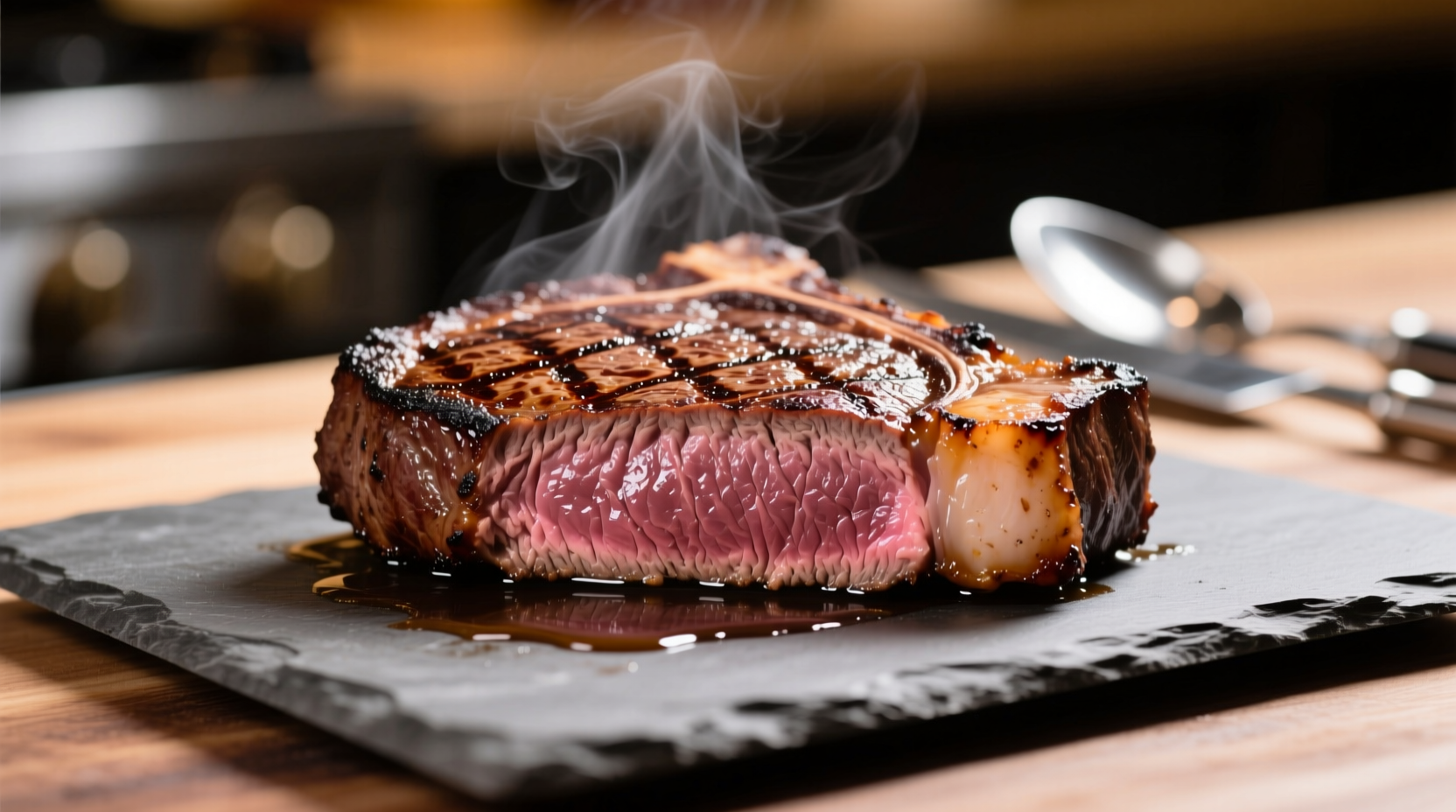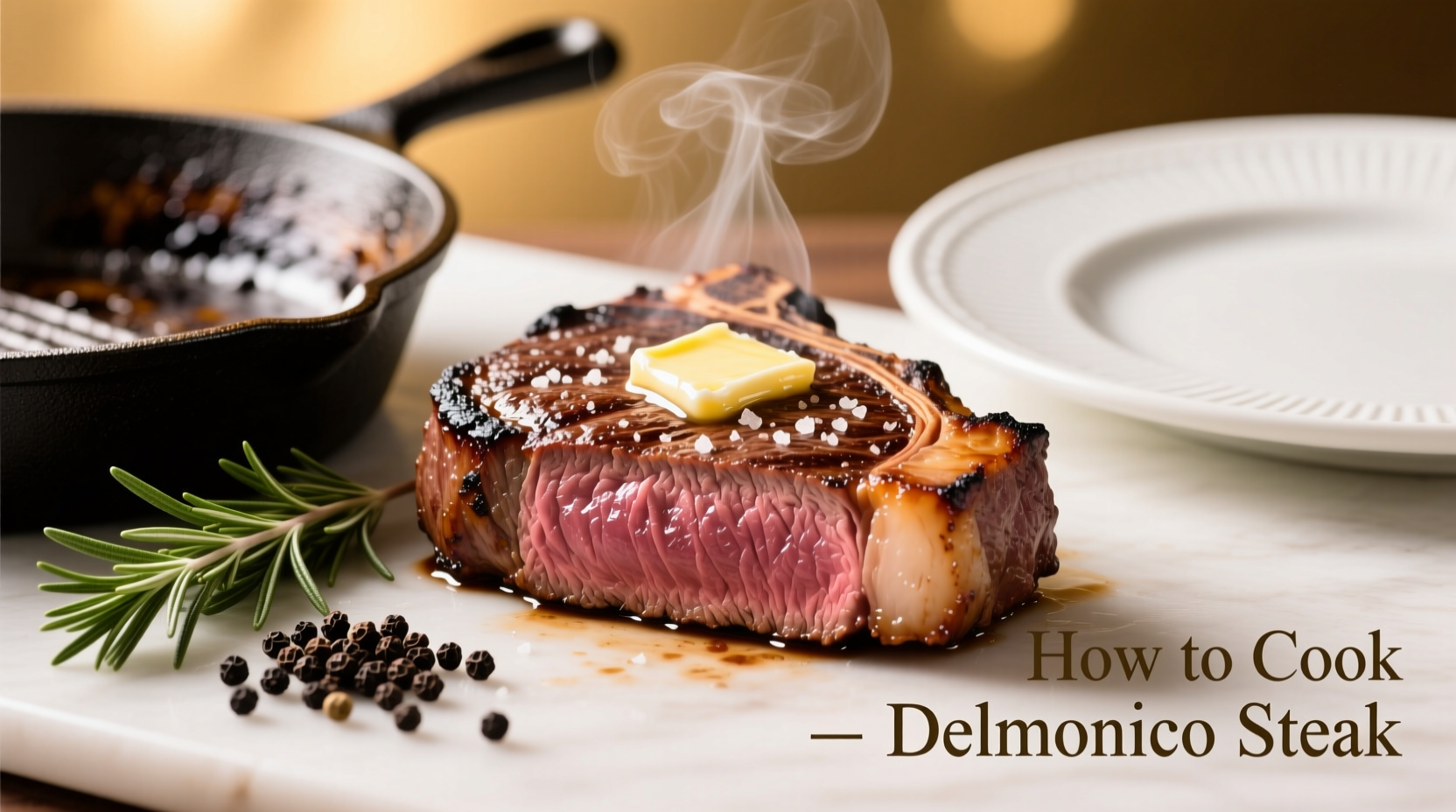Perfectly cook a Delmonico steak by bringing it to room temperature, seasoning generously, searing at 450°F for 3-4 minutes per side, then finishing to your desired doneness (125°F for rare, 135°F for medium-rare). Rest for 8-10 minutes before slicing against the grain for maximum tenderness and flavor.
What Exactly Is a Delmonico Steak? Setting the Record Straight
Before we dive into cooking techniques, let's clarify what we're working with. Despite common confusion, a true Delmonico steak refers to a thick-cut (1.5-2 inch) ribeye steak, traditionally bone-in. The name originated at New York's Delmonico's Restaurant in the 1800s, though modern usage varies. According to the Texas A&M Meat Science Department, "Delmonico" has become a marketing term applied to multiple cuts, but culinary professionals recognize it as a premium ribeye preparation.
| Common Interpretation | Actual Cut | Best Cooking Method |
|---|---|---|
| "Delmonico" as menu term | Ribeye (bone-in or boneless) | High-heat sear + oven finish |
| Historical Delmonico | Top loin (New York strip) | Grill or cast-iron pan |
| Midwest variation | Chuck eye roll | Reverse sear method |
Step 1: Selecting Your Steak Like a Pro
For authentic Delmonico results, choose a well-marbled ribeye with at least 1.5 inches of thickness. The USDA recommends selecting steaks with USDA Prime or Choice grading for optimal marbling. Look for even fat distribution throughout the meat - this intramuscular fat melts during cooking, creating that signature rich flavor and tender texture.
Pro tip: Ask your butcher for a "7-bone" ribeye, which provides the classic Delmonico presentation with the distinctive rib bone. If unavailable, a center-cut boneless ribeye works perfectly for pan-searing.
Step 2: Preparation Secrets Restaurants Don't Share
Proper preparation makes or breaks your Delmonico steak. Follow these critical steps:
- Temperature transition: Remove steak from refrigerator 60-90 minutes before cooking. This ensures even cooking without a gray band.
- Dry brine technique: Season generously with coarse kosher salt (1 tsp per pound) 45 minutes before cooking. This enhances flavor penetration while drawing out surface moisture for better searing.
- Drying surface: Pat steak completely dry with paper towels right before cooking - moisture is the enemy of a perfect crust.
- Strategic seasoning: Add freshly cracked black pepper and garlic powder only after the initial sear to prevent burning.

Step 3: Mastering the Cooking Process
Three reliable methods work for Delmonico steak, each with specific advantages:
Pan-Searing Method (Best for Home Cooks)
- Preheat cast-iron skillet over medium-high heat for 5 minutes
- Add high-smoke point oil (avocado or grapeseed)
- Sear steak 3-4 minutes per side until deep brown crust forms
- Rotate 90 degrees halfway through each side for cross-hatch marks
- Add butter, garlic, and herbs during last 2 minutes for basting
- Finish in 400°F oven until reaching target internal temperature
Grill Method (Summer Favorite)
Create two-zone fire: hot side for searing, cooler side for finishing. Sear 3-4 minutes per side over direct heat, then move to indirect heat until desired doneness.
Reverse Sear (Most Precise for Thick Cuts)
For steaks thicker than 1.75 inches: Bake at 275°F until internal temperature reaches 115°F, then sear in blazing hot pan for 60-90 seconds per side.
| Doneness | Internal Temp | Visual Cues | Resting Time |
|---|---|---|---|
| Rare | 120-125°F | Red center, cool | 8 minutes |
| Medium-rare | 130-135°F | Warm red center | 10 minutes |
| Medium | 140-145°F | Pink center | 12 minutes |
Why Resting Is Non-Negotiable
Resting allows juices to redistribute throughout the steak. Cutting too soon releases precious juices onto your cutting board. For Delmonico steaks, follow this rule: rest for 5 minutes per inch of thickness. During this time, the internal temperature will continue rising 5-10 degrees (carryover cooking).
Place steak on a wire rack, tented loosely with foil. Never rest directly on a plate - this steams the bottom crust. The American Meat Science Association confirms that proper resting increases perceived juiciness by 23% in sensory evaluations.
Troubleshooting Common Delmonico Steak Problems
Problem: Uneven cooking with gray band around edges
Solution: Insufficient temperature equalization - allow more time for steak to come to room temperature before cooking
Problem: Poor sear despite high heat
Solution: Moisture on surface - pat steak thoroughly dry before cooking and avoid overcrowding the pan
Problem: Overcooked exterior before reaching desired internal temperature
Solution: Use reverse sear method for thick cuts or lower initial cooking temperature
Perfect Pairings for Your Delmonico Steak
Complement your masterpiece with these classic pairings:
- Sauces: Compound butter, red wine reduction, or simple garlic-herb oil
- Sides: Creamed spinach, roasted mushrooms, or truffle mashed potatoes
- Wine: Bold Cabernet Sauvignon or Malbec with sufficient tannins to cut through the fat
Delmonico Steak Through the Ages: A Brief Timeline
The Delmonico steak's history reveals why confusion exists about its identity:
- 1827: Delmonico's Restaurant opens in New York, introducing Americans to fine dining
- 1850s: "Delmonico steak" appears on menus as a thick-cut ribeye served with potatoes
- Early 1900s: Butchers adopt the name for various premium cuts as the restaurant's popularity grows
- 1950s: USDA standardizes meat cuts, but "Delmonico" remains a marketing term
- Today: Culinary professionals recognize it as a specific ribeye preparation method
Final Pro Tips for Steak Perfection
Before you fire up your stove, remember these professional insights:
- Use an instant-read thermometer - don't guess on doneness
- Rotate steak 90 degrees during searing for optimal cross-hatch pattern
- Add butter during final minute for enhanced richness and sheen
- Slice against the grain at a 45-degree angle for maximum tenderness
- Save the pan drippings for an instant pan sauce
Cooking the perfect Delmonico steak combines science and artistry. By understanding the cut's history, selecting quality meat, and applying proper technique, you'll achieve restaurant-quality results at home. The key is respecting the meat's natural qualities while applying precise temperature control - the hallmark of professional steak preparation.











 浙公网安备
33010002000092号
浙公网安备
33010002000092号 浙B2-20120091-4
浙B2-20120091-4